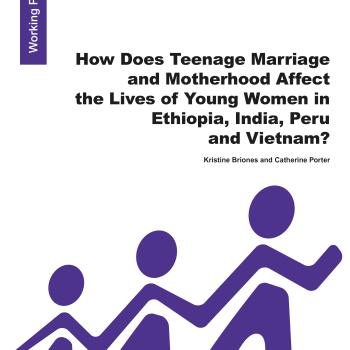Publication Information

This working paper examines the characteristics of young women who have been married, cohabited, or given birth in their teenage years in four low - or middle -income countries; Ethiopia, India, Peru and Vietnam. It finds that the rates of teen marriage are highest in India, but a high proportion of Peruvian girls are already cohabiting or mothers by the age of 19. The paper compares those who were married/cohabiting as teenagers with those who were not, at age 22, and finds that young women who were married/cohabiting in their teens are significantly less likely to have completed high school in all countries, and less likely to believe in equality between men and women, and score lower on measures of empowerment. Some of these observed differences were apparent before their marriage, so it is difficult to make a causal attribution to the event of marrying, or to early life circumstances. However, even conditional on other correlates, the probability of finishing high school is 15 - 25 per cent lower for teen-married women, and the fall in agency between ages 15 and 22 is significantly lower than for those who were not married young.
This quantitative analysis complements qualitative findings from a companion study (Winter 2018), showing that lack of support for women who marry young exacerbates disadvantage from poverty and gender norms.

This working paper examines the characteristics of young women who have been married, cohabited, or given birth in their teenage years in four low - or middle -income countries; Ethiopia, India, Peru and Vietnam. It finds that the rates of teen marriage are highest in India, but a high proportion of Peruvian girls are already cohabiting or mothers by the age of 19. The paper compares those who were married/cohabiting as teenagers with those who were not, at age 22, and finds that young women who were married/cohabiting in their teens are significantly less likely to have completed high school in all countries, and less likely to believe in equality between men and women, and score lower on measures of empowerment. Some of these observed differences were apparent before their marriage, so it is difficult to make a causal attribution to the event of marrying, or to early life circumstances. However, even conditional on other correlates, the probability of finishing high school is 15 - 25 per cent lower for teen-married women, and the fall in agency between ages 15 and 22 is significantly lower than for those who were not married young.
This quantitative analysis complements qualitative findings from a companion study (Winter 2018), showing that lack of support for women who marry young exacerbates disadvantage from poverty and gender norms.

